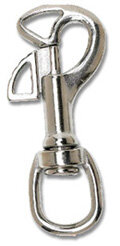The bungeed necklass is the best thing since sliced bread...
I am probably an outlier but I find a bungied necklace on an octo or backup regulator annoying since I often find myself head-down. The second stage swings on the necklace and either interferes with neck movement or actually swings into view.
I do use a bungie necklace my primary, but also use a snorkel on all but the shortest surface swims Ive been diving since snorkels were the norm and do a lot of freediving. I will often freedive in Scuba to get under a kelp obstacle rather than waste gas. I keep the secondary/octo bungied to my harness lower on my torso so I can see it and replace it after being pulled out. That allows me to position the diaphragm up to minimize freeflows when jumping overboard. It also makes it easy to reach if it does freeflow.
At best, all the solutions I have seen and tried are less than elegant. There is still room for innovation here.
Rather than bolt snaps, consider a butterfly snap, especially if you wear gloves.




